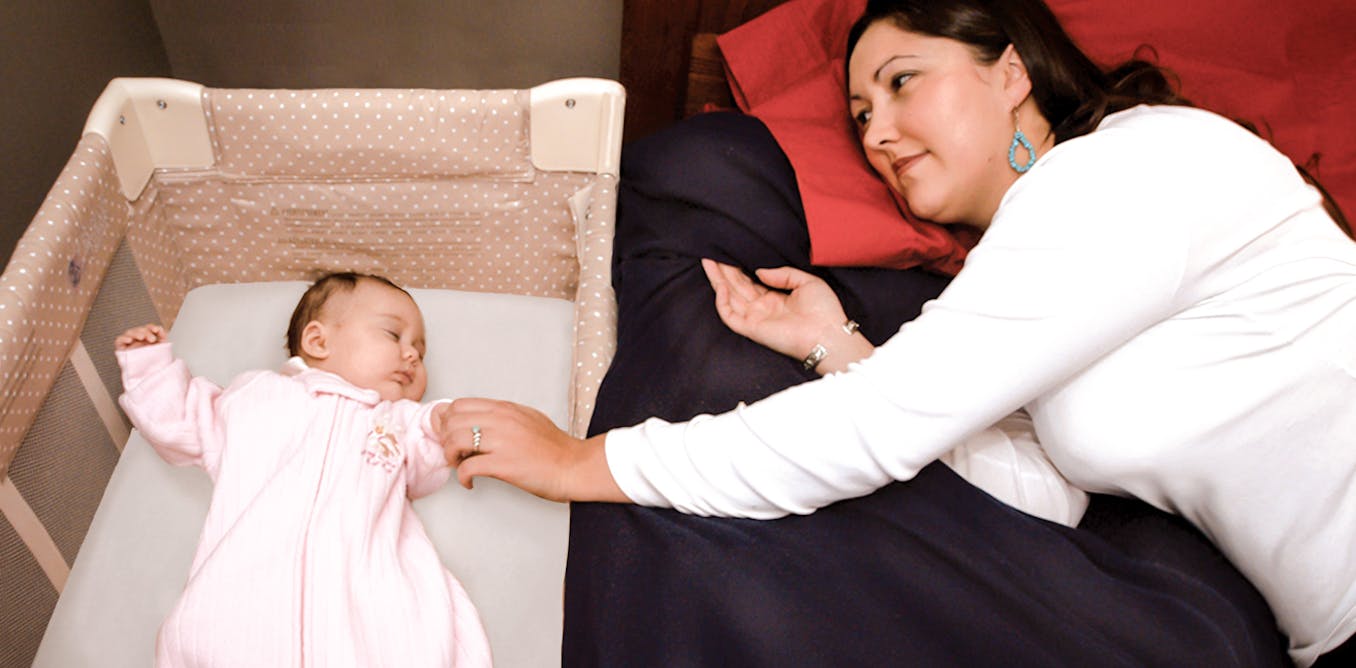The tragedy of sudden unexpected infant deaths – and how bedsharing, maternal smoking and stomach sleeping all contribute
The tragedy of sudden unexpected infant deaths – and how bedsharing, maternal smoking and stomach sleeping all ... The Conversation Indonesia


Unsafe Sleep Practices and Sudden Unexpected Infant Deaths in the U.S.

Unsafe sleep practices are a significant factor in most sudden unexpected infant deaths (SUID) in the United States. According to our recent study published in Pediatrics, three-quarters of infants who died from SUID were affected by multiple unsafe practices, and nearly 60% shared a sleep surface with another person.
Sudden Unexpected Infant Death (SUID)
SUID refers to the sudden and unexpected death of infants under 1 year old without an obvious cause before investigation. In the U.S., SUID accounts for approximately 3,400 deaths annually. These deaths can be attributed to sudden infant death syndrome (SIDS), accidental suffocation and strangulation in bed, or other ill-defined and unknown causes.
However, the American Academy of Pediatrics and various other agencies strongly discourage infants from sharing a sleep surface with parents, other adults, or other infants and children due to the increased risk of these deaths.
Study Findings
Our study analyzed data from the Centers for Disease Control and Prevention’s SUID Case Registry, which collects information from child death review teams in 23 states, cities, or counties. The study included 7,595 infants who died from SUID between 2011 and 2020.
Key characteristics of infants who were bedsharing at the time of death were as follows:
- 0 to 3 months old, non-Hispanic Black, and insured by Medicaid or other public plan
- Found lying on their back in an adult bed, chair, or couch
- Affected by a higher number of unsafe sleep factors
- Exposed to maternal cigarette smoking while in the womb
- Supervised by someone impaired by drugs or alcohol at the time of death
- No crib in the home
Among infants who did not share a sleep surface, only one-third were sleeping in the recommended back position, and three-quarters were in sleep areas with soft bedding such as pillows, comforters, or bumper pads at the time of death. Additionally, three-quarters of all sudden unexpected infant deaths in our study were affected by multiple unsafe sleep factors.
Importance of Addressing SUID
Sudden unexpected infant death rates in the U.S. have shown minimal changes over the past 20 years. However, racial-ethnic disparities in these deaths are widening, primarily due to increasing rates among non-Hispanic Black infants.
Our study emphasizes that the majority of these deaths are preventable by following the guidelines for safe infant sleep provided by the American Academy of Pediatrics and the National Institute of Child Health and Human Development.
The recommended guidelines include:
- Placing the baby to sleep on a firm, flat surface
- Having the baby sleep in their parents’ room for the first six months on a separate sleep surface designed for infants
- Keeping the baby’s sleep space free of soft objects such as pillows and loose bedding
- Avoiding alcohol, marijuana, opioids, and illicit drug use during pregnancy and after birth
- Avoiding smoke and nicotine exposure during pregnancy and after birth
Despite knowledge of these recommendations, many parents find it challenging to follow them consistently. Factors such as exhaustion, cultural practices, and personal beliefs can influence parents’ adherence to safe sleep practices.
Health care providers should consider these factors when advising families. Additionally, programs that provide free cribs to parents who cannot afford them are crucial in ensuring a safe sleep space for infants.
Future Research and Conclusion
Further research is needed to identify the most effective ways to educate families about safe infant sleep. Several ongoing studies are utilizing innovative methods to engage and educate parents, starting from pregnancy and continuing after the baby is born.
Focusing on families at the highest risk, as demonstrated in our study, is essential to eliminate sudden unexpected infant deaths and address the persistent racial-ethnic disparities. By prioritizing the Sustainable Development Goals (SDGs) related to health and well-being, we can work towards reducing these preventable deaths and ensuring a safer future for all infants.
The Research Brief is a short take on interesting academic work.
SDGs, Targets, and Indicators
| SDGs | Targets | Indicators |
|---|---|---|
| SDG 3: Good Health and Well-being | 3.2: By 2030, end preventable deaths of newborns and children under 5 years of age | – Number of sudden unexpected infant deaths – Number of infants affected by unsafe sleep practices |
| SDG 10: Reduced Inequalities | 10.3: Ensure equal opportunity and reduce inequalities of outcome, including through eliminating discriminatory laws, policies, and practices | – Racial-ethnic disparities in sudden unexpected infant deaths – Rates of sudden unexpected infant deaths among non-Hispanic Black infants |
| SDG 16: Peace, Justice, and Strong Institutions | 16.1: Significantly reduce all forms of violence and related death rates everywhere | – Number of infants affected by unsafe sleep practices due to bedsharing with impaired individuals |
1. Which SDGs are addressed or connected to the issues highlighted in the article?
SDG 3: Good Health and Well-being
The article addresses the issue of sudden unexpected infant deaths (SUID), which falls under the scope of SDG 3. This goal aims to ensure good health and well-being for all, including reducing preventable deaths of newborns and children.
SDG 10: Reduced Inequalities
The article highlights the widening racial-ethnic disparities in sudden unexpected infant deaths, particularly among non-Hispanic Black infants. This aligns with SDG 10, which focuses on reducing inequalities and ensuring equal opportunities for all.
SDG 16: Peace, Justice, and Strong Institutions
The article mentions that infants who were bedsharing at the time of death were being supervised by someone impaired by drugs or alcohol. This connects to SDG 16, which aims to reduce violence and related death rates.
2. What specific targets under those SDGs can be identified based on the article’s content?
Target 3.2: By 2030, end preventable deaths of newborns and children under 5 years of age
The article emphasizes the need to prevent sudden unexpected infant deaths through safe sleep practices. This aligns with Target 3.2, which aims to end preventable deaths of newborns and children under 5 years of age.
Target 10.3: Ensure equal opportunity and reduce inequalities of outcome, including through eliminating discriminatory laws, policies, and practices
The article highlights the increasing rates of sudden unexpected infant deaths among non-Hispanic Black infants, indicating a need to address racial-ethnic disparities. This relates to Target 10.3, which focuses on reducing inequalities and eliminating discriminatory practices.
Target 16.1: Significantly reduce all forms of violence and related death rates everywhere
The article mentions that infants who were bedsharing at the time of death were being supervised by someone impaired by drugs or alcohol. This indicates a need to address unsafe sleep practices and reduce violence-related death rates, aligning with Target 16.1.
3. Are there any indicators mentioned or implied in the article that can be used to measure progress towards the identified targets?
The article provides several indicators that can be used to measure progress towards the identified targets:
– Number of sudden unexpected infant deaths: This indicator can be used to track progress towards Target 3.2 of ending preventable deaths of newborns and children under 5 years of age.
– Number of infants affected by unsafe sleep practices: This indicator can also be used to measure progress towards Target 3.2, as it reflects the prevalence of unsafe sleep practices contributing to sudden unexpected infant deaths.
– Racial-ethnic disparities in sudden unexpected infant deaths: This indicator can be used to monitor progress towards Target 10.3 of reducing inequalities and addressing disparities in outcomes.
– Rates of sudden unexpected infant deaths among non-Hispanic Black infants: This indicator further highlights the need to address racial-ethnic disparities and can be used to measure progress towards Target 10.3.
– Number of infants affected by unsafe sleep practices due to bedsharing with impaired individuals: This indicator reflects the need to reduce violence-related death rates and can be used to track progress towards Target 16.1.
4. SDGs, Targets, and Indicators
| SDGs | Targets | Indicators |
|---|---|---|
| SDG 3: Good Health and Well-being | 3.2: By 2030, end preventable deaths of newborns and children under 5 years of age | – Number of sudden unexpected infant deaths – Number of infants affected by unsafe sleep practices |
| SDG 10: Reduced Inequalities | 10.3: Ensure equal opportunity and reduce inequalities of outcome, including through eliminating discriminatory laws, policies, and practices | – Racial-ethnic disparities in sudden unexpected infant deaths – Rates of sudden unexpected infant deaths among non-Hispanic Black infants |
| SDG 16: Peace, Justice, and Strong Institutions | 16.1: Significantly reduce all forms of violence and related death rates everywhere | – Number of infants affected by unsafe sleep practices due to bedsharing with impaired individuals |
Behold! This splendid article springs forth from the wellspring of knowledge, shaped by a wondrous proprietary AI technology that delved into a vast ocean of data, illuminating the path towards the Sustainable Development Goals. Remember that all rights are reserved by SDG Investors LLC, empowering us to champion progress together.
Source: theconversation.com

Join us, as fellow seekers of change, on a transformative journey at https://sdgtalks.ai/welcome, where you can become a member and actively contribute to shaping a brighter future.







